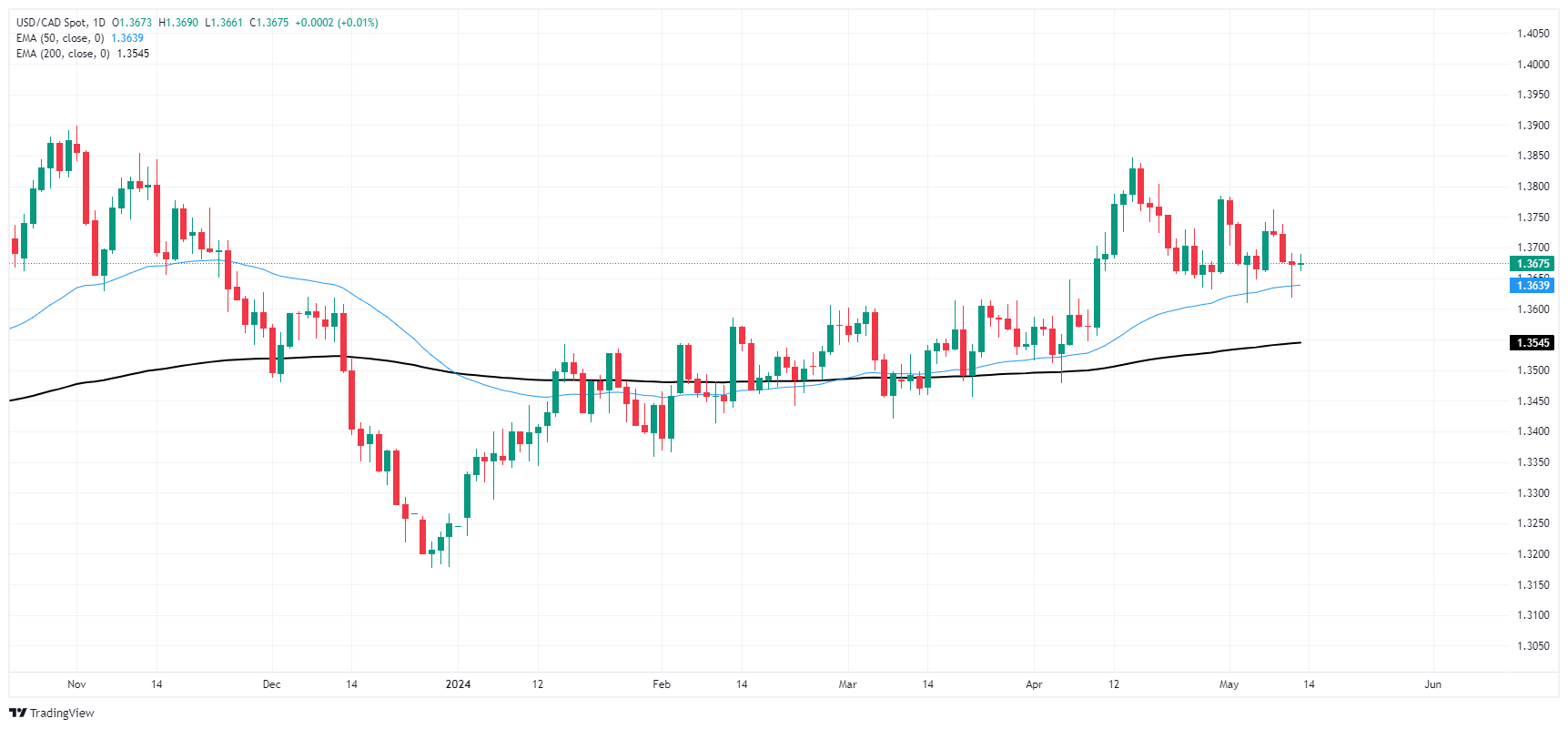Canadian Dollar flattens on tepid Monday

- Canadian Dollar middles as markets focus on Fed rate cuts.
- Canada issued far fewer building permits than expected in March.
- Markets continue to bet on two rate cuts in 2024 despite cautionary Fedspeak.
The Canadian Dollar (CAD) churned within familiar levels on Monday as a data-light economic calendar kicks off the new trading week. Investors continue to hinge risk appetite on rate cut expectations from the Federal Reserve (Fed) with updates to US inflation data due later in the week.
Canada saw a sharper-than-expected decline in new Building Permits issued in March, but data from early in the housing cycle remains low-tier and limited-impact. Canadian economic data remains low-priority for the rest of the week, leaving market participants to focus on the US Producer Price Index (PPI) due on Tuesday, followed by US Consumer Price Index (CPI) inflation and Retail Sales on Wednesday.
Daily digest market movers: Canadian Dollar stuck in the middle as rate cut hopes dominate
- Canadian Building Permits issued in March declined -11.7%, far below the -4.6% forecast, the sharpest decline in MoM Building Permits since June of 2023. April’s Building Permits were also revised slightly lower to 8.9% from 9.3%.
- The latest Survey of Consumer Expectations from the New York Fed noted that surveyed consumers expect inflation to rise to 3.3% over the next year, higher than the previous survey’s 3.0%.
- A Reuters survey of 108 economists showed nearly two-thirds of respondents still expect a quarter-point cut from the Fed by September despite none expecting inflation to reach the Fed’s 2% target before 2026.
- YoY US Producer Price Index inflation is expected to rise to 2.2% on Tuesday, compared to the previous period’s 2.1%.
- Wednesday’s US CPI inflation print for April is forecast to hold steady at 0.4% MoM, with the YoY figure expected to tick down to 3.4% from 3.5%.
Canadian Dollar PRICE Today
The table below shows the percentage change of Canadian Dollar (CAD) against listed major currencies today. Canadian Dollar was the strongest against the British Pound.
| USD | EUR | GBP | JPY | CAD | AUD | NZD | CHF | |
|---|---|---|---|---|---|---|---|---|
| USD | 0.22% | 0.28% | -0.27% | -0.05% | 0.12% | -0.11% | -0.14% | |
| EUR | -0.22% | 0.11% | -0.49% | -0.25% | -0.07% | -0.31% | -0.34% | |
| GBP | -0.28% | -0.11% | -0.53% | -0.37% | -0.19% | -0.42% | -0.45% | |
| JPY | 0.27% | 0.49% | 0.53% | 0.25% | 0.36% | 0.22% | 0.12% | |
| CAD | 0.05% | 0.25% | 0.37% | -0.25% | 0.14% | -0.05% | -0.00% | |
| AUD | -0.12% | 0.07% | 0.19% | -0.36% | -0.14% | -0.13% | -0.27% | |
| NZD | 0.11% | 0.31% | 0.42% | -0.22% | 0.05% | 0.13% | -0.03% | |
| CHF | 0.14% | 0.34% | 0.45% | -0.12% | 0.00% | 0.27% | 0.03% |
The heat map shows percentage changes of major currencies against each other. The base currency is picked from the left column, while the quote currency is picked from the top row. For example, if you pick the Canadian Dollar from the left column and move along the horizontal line to the US Dollar, the percentage change displayed in the box will represent CAD (base)/USD (quote).
Technical analysis: Canadian Dollar middles as markets hold steady
The Canadian Dollar (CAD) trades tightly on Monday, sticking close to the new trading week’s opening bids. The CAD is trading within a quarter of a percent against nearly all of its major currency peers on Monday and holding next to flat against the US Dollar (USD).
The USD/CAD is struggling to find momentum on Monday, holding in place near 1.3680. Bids are treading water just above a near-term supply zone from 1.3660 to 1.3615. Topside momentum is capped by the 200-hour Exponential Moving Average (EMA) just below the 1.3700 handle, while short-sellers have been unsuccessful in dragging the pair back down to 1.3600.
USD/CAD hourly chart
USD/CAD daily chart
Inflation FAQs
Inflation measures the rise in the price of a representative basket of goods and services. Headline inflation is usually expressed as a percentage change on a month-on-month (MoM) and year-on-year (YoY) basis. Core inflation excludes more volatile elements such as food and fuel which can fluctuate because of geopolitical and seasonal factors. Core inflation is the figure economists focus on and is the level targeted by central banks, which are mandated to keep inflation at a manageable level, usually around 2%.
The Consumer Price Index (CPI) measures the change in prices of a basket of goods and services over a period of time. It is usually expressed as a percentage change on a month-on-month (MoM) and year-on-year (YoY) basis. Core CPI is the figure targeted by central banks as it excludes volatile food and fuel inputs. When Core CPI rises above 2% it usually results in higher interest rates and vice versa when it falls below 2%. Since higher interest rates are positive for a currency, higher inflation usually results in a stronger currency. The opposite is true when inflation falls.
Although it may seem counter-intuitive, high inflation in a country pushes up the value of its currency and vice versa for lower inflation. This is because the central bank will normally raise interest rates to combat the higher inflation, which attract more global capital inflows from investors looking for a lucrative place to park their money.
Formerly, Gold was the asset investors turned to in times of high inflation because it preserved its value, and whilst investors will often still buy Gold for its safe-haven properties in times of extreme market turmoil, this is not the case most of the time. This is because when inflation is high, central banks will put up interest rates to combat it. Higher interest rates are negative for Gold because they increase the opportunity-cost of holding Gold vis-a-vis an interest-bearing asset or placing the money in a cash deposit account. On the flipside, lower inflation tends to be positive for Gold as it brings interest rates down, making the bright metal a more viable investment alternative.
Information on these pages contains forward-looking statements that involve risks and uncertainties. Markets and instruments profiled on this page are for informational purposes only and should not in any way come across as a recommendation to buy or sell in these assets. You should do your own thorough research before making any investment decisions. FXStreet does not in any way guarantee that this information is free from mistakes, errors, or material misstatements. It also does not guarantee that this information is of a timely nature. Investing in Open Markets involves a great deal of risk, including the loss of all or a portion of your investment, as well as emotional distress. All risks, losses and costs associated with investing, including total loss of principal, are your responsibility. The views and opinions expressed in this article are those of the authors and do not necessarily reflect the official policy or position of FXStreet nor its advertisers. The author will not be held responsible for information that is found at the end of links posted on this page.
If not otherwise explicitly mentioned in the body of the article, at the time of writing, the author has no position in any stock mentioned in this article and no business relationship with any company mentioned. The author has not received compensation for writing this article, other than from FXStreet.
FXStreet and the author do not provide personalized recommendations. The author makes no representations as to the accuracy, completeness, or suitability of this information. FXStreet and the author will not be liable for any errors, omissions or any losses, injuries or damages arising from this information and its display or use. Errors and omissions excepted.
The author and FXStreet are not registered investment advisors and nothing in this article is intended to be investment advice.



